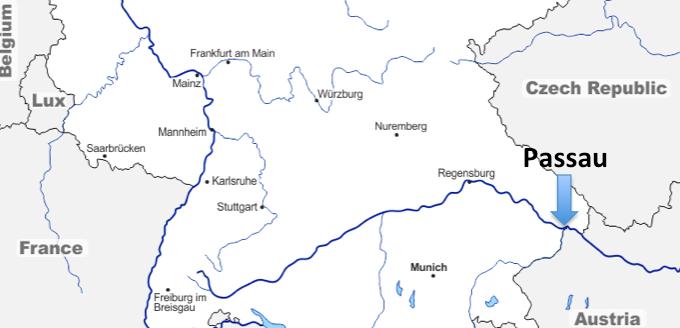
A European Journey #34 – Passau (Germany)
Last week we were in Merano to discover the story of Valentine, the missionary who finished his life there after having had an unsuccessful ministry in Passau.
I finished the stage by saying that even if Valentine’s mission in the Bavarian town seemed to have failed, God redeemed the situation.
So today we will visit Passau to see what happened after Valentine had left. Passauis a German town located right at the border with Austria, and it is also where the Inn River flows into the Danube. It was thus understandably a strategic location in Roman times. For this reason, there was already a Roman colony at the times of Jesus Christ.
The old town is situated near the point where the two rivers meet. This is where we find the Dom St. Stephan (St. Stephen’s Cathedral). From there, we will walk along the Inn river and then cross it by the pedestrian bridge called Innsteg.
On the other side of the river, we will reach another church called Severinkirche. The street in front of the church is called Am Severinstor (to the gate of Severin). As the name indicates, this street leads to the old gate Severintor. If we pass the gate and walk for another three hundred meters, we reach the Foundation of the Catholic Parish Church (Katholische Pfarrkirchenstiftung) which is again dedicated to St. Severin. So it is clear to see that this residential area, which is called Innstadt, has something to do with a man called Severin or Severinus.
So who was this Severin and what connection did he have with Passau?
As was the case with Valentine, Severin’s origins are unclear. Some think that he might have come from Southern Italy (where the town San Severo in Apulia bears his name) or North Africa. Nevertheless, the first traces we find about him are in the Roman province of Pannonia, a region covering modern-day Hungary and parts of the surrounding countries such as Austria. In his day, the Romans had lost control of the province, which was then facing the invasion of the Huns.
In this climate of anarchy, many were fleeing from the region. But Severin saw an opportunity to be a light in this context of darkness and destruction. There he began to clothe the naked, feed the hungry and provide shelter to the locals who were in danger of death. Many people quickly gathered under his wing. According to one story,he even walked barefoot over frozen rivers in winter to collect food and clothes for them.
Severin also preached the Gospel, with a special emphasis on Christian charity. People came to hear him from faraway lands and many became his followers. Severin thus built several monasteries, including one in what is modern-day Vienna (Vindobona) and one in Mautern an der Donau (Favianae), Austria. But he also built one right here in Innstadt.
There is another fascinating story that is worth telling. While Severin was committed to works of compassion, he was also ready to defend his people against aggression. One day in Vienna, the Huns took children as captives from amonghis followers. Severin, who saw their despair, encouraged them not to be afraid of their aggressors but to put their trust in God and chase them. Even though they were fewer in number and weaker, the story tells that they succeeded in freeing all the captives.
Here in Passau, Severin built a small cell for himself, aiming to live a humble life before the Lord. This time, the citizens of Passau seemed more inclined to receive the Gospel than with Valentine. Perhaps, one reason for this was that Severin combined teaching sound doctrine with showing compassion whereas Valentine focused on confronting the Arian heresy all the while avoiding their company.
Even if he had intended to build a cell only for himself, Severin’s fame attracted many people to visit him and even to live with him.
Also, several prominent rulers of the time came to seek his counsel for their military enterprises. Among others, he counselled the Arian chief of the Rugii, a tribe which had settled in the region and even Odoacer, a Germanic ruler who later became king of Italy. Each time, Severin spoke for peace and encouraged his listeners not to commit cruelties against the people of the territories they intended to invade. When he knew that some of the rulers who sought his counsel were holding people captive, he would also plead with them for their freedom.
Through his works of mercy, Severin drew many Germanic tribes to faith in Jesus Christ, and through his counselling to the rulers of his day, he also contributed greatly to the pacification of a Western Europe.
Today, this peaceful area of Passau stands as a reminder of how God can still use people like Severin to bring his kingdom on earth as it is in heaven.
Next week, we will discover how one of the main Germanic rulers of the time turned to Christianity, thus setting the course of the following centuries in Western Europe.
See you next week somewhere else in Europe.
Cédric Placentino
Schuman Centre convener for Italian and French Europe
Follow A European Journey here.

This Post Has 0 Comments